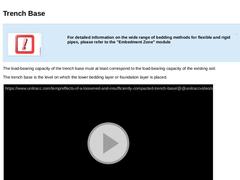
|
For detailed information on the wide range of bedding methods for flexible and rigid pipes, please refer to the "Embedment Zone" module. . The load-bearing capacity of the trench base must at least correspond to the load-bearing capacity of the existing soil. The trench base is the level on which the lower bedding layer or foundation layer is placed. (Video: Effects of a loosened and insufficiently compacted trench base) Improper construction … |
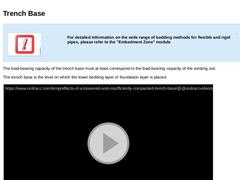
|
For detailed information on the wide range of bedding methods for flexible and rigid pipes, please refer to the "Embedment Zone" module . The load-bearing capacity of the trench base must at least correspond to the load-bearing capacity of the existing soil. The trench base is the level on which the lower bedding layer or foundation layer is placed. (Video: Effects of a loosened and insufficiently compacted trench base) Improper construction … |

|
Improper construction of the bedding does not provide the necessary load-bearing capacity for the subsequent pipe support and leads to subsidence of the pipes. (Video: Damage consequences of insufficient compaction of the lower bedding layer (pipes resting on uneven bedding material)) In the case of pipes with bells, bell holes must be made in the compacted lower bedding layer in order to avoid a support situation, as with a beam on two supports, and … |
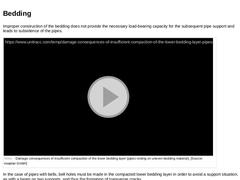
|
Improper construction of the bedding does not provide the necessary load-bearing capacity for the subsequent pipe support and leads to subsidence of the pipes. (Video: Damage consequences of insufficient compaction of the lower bedding layer (pipes resting on uneven bedding material)) In the case of pipes with bells, bell holes must be made in the compacted lower bedding layer in order to avoid a support situation, as with a beam on two supports, and … |
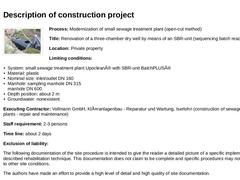
|
(Image: 267193 - Titelbild Dokumentation) Process: Modernization of small sewage treatment plant (open-cut method) Title: Renovation of a three-chamber dry well by means of an SBR-unit (sequencing batch reactor) Location: Private property Limiting conditions: - System: small sewage treatment plant Upoclean® with SBR-unit BatchPLUS®
- Material: plastic
- Nominal size: inlet/outlet DN 160
- Manhole: sampling manhole DN 315
manhole DN 600
- Depth position: about …
|
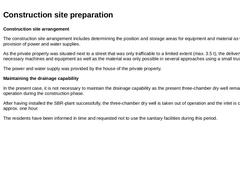
|
Construction site arrangement The construction site arrangement includes determining the position and storage areas for equipment and material as well as the provision of power and water supplies. As the private property was situated next to a street that was only trafficable to a limited extent (max. 3.5 t), the delivery of the necessary machines and equipment as well as the material was only possible in several approaches using a small truck. The … |
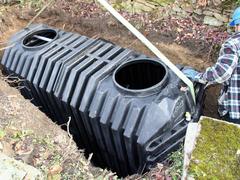
|
Installation of excavation The present inlet to the three-chamber dry well is carefully laid open by means of a pickaxe and a shovel. The position and dimensions of the excavation for the HD-PE-container must be selected and arranged in such a way that the new small sewage treatment plant, upon its completion, can be connected to the present inlet. The present plants in the range of the excavation are partly trimmed by a chain saw and/or removed … |
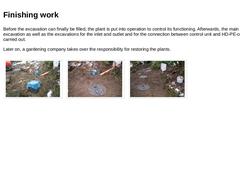
|
Before the excavation can finally be filled, the plant is put into operation to control its functioning. Afterwards, the main filling of the excavation as well as the excavations for the inlet and outlet and for the connection between control unit and HD-PE-container is carried out. Later on, a gardening company takes over the responsibility for restoring the plants. | (Image: Final filling of excavation) | (Image: Final filling of excavation) | (Image: … |
|

|
Modernization of a three-chamber dry well using the open-cut method by means of the new installation of an SBR-unit. |
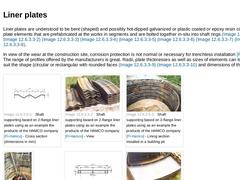
|
Liner plates are understood to be bent (shaped) and possibly hot-dipped galvanized or plastic coated or epoxy resin coated steel plate elements that are prefabricated at the works in segments and are bolted together in-situ into shaft rings (Bild 12.5.2.2) (Bild 12.5.2.2) (Bild 12.5.2.2) (Bild 12.5.2.2) (Bild 12.5.2.2) (Bild 12.5.2.2) (Bild 12.5.2.2) (Bild 12.5.2.2). In view of the wear at the construction site, corrosion protection is not normal … |
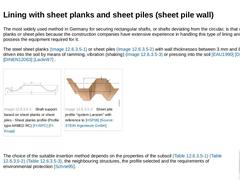
|
The most widely used method in Germany for securing rectangular shafts, or shafts deviating from the circular, is that of using sheet planks or sheet piles because the construction companies have extensive experience in handling this type of lining and usually also possess the equipment required for it. The steel sheet planks (Bild 12.5.2.4) or sheet piles (Bild 12.5.2.4) with wall thicknesses between 3 mm and 8 mm are driven into the soil by means … |
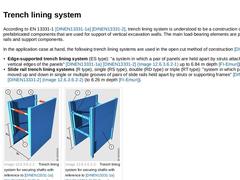
|
According to EN 13331-1 [DINEN13331-1a] [DINEN13331-2], trench lining system is understood to be a construction of prefabricated components that are used for support of vertical excavation walls. The main load-bearing elements are panels, slide rails and support components. In the application case at hand, the following trench lining systems are used in the open cut method of construction [DINEN13331] : - Edge-supported trench lining system (ES type): "…
|
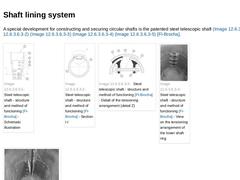
|
A special development for constructing and securing circular shafts is the patented steel telescopic shaft (Bild 12.5.2.5.2) (Bild 12.5.2.5.2) (Bild 12.5.2.5.2) (Bild 12.5.2.5.2) (Bild 12.5.2.5.2) [FI-Brocha]. | (Image: Steel telescopic shaft - structure and method of functioning [FI-Brocha] - Schematic illustration) | (Image: Steel telescopic shaft - structure and method of functioning [FI-Brocha] - Section I-I) | (Image: Steel telescopic shaft - structure … |
|
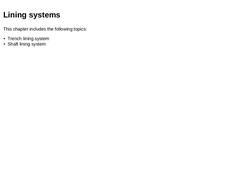
|
|
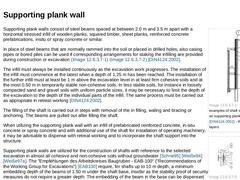
|
|
(Image: Application examples of shaft securing based on supporting planks wall [DIN4124c] - With two brace layers)
|
|
(Image: Application examples of shaft securing based on supporting planks wall [DIN4124c] - Detail view (plan view and section))
|
Supporting plank walls consist of steel beams spaced at between 2.0 m and 3.5 m apart with a horizontal stressed infill of wooden planks, squared timber, sheet planks, reinforced concrete prefabrications, … |
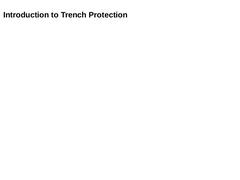
|
(Video: Robert Stein - Introduction to Trench Protection 2023 - Neu) |
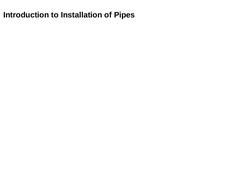
|
(Video: Robert Stein - Introduction to Pipe Installation 2023) |
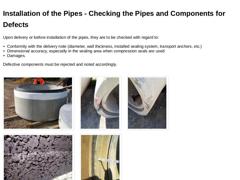
|
Upon delivery or before installation of the pipes, they are to be checked with regard to: -
Conformity with the delivery note (diameter, wall thickness, installed sealing system, transport anchors, etc.)
-
Dimensional accuracy, especially in the sealing area when compression seals are used
-
Damages.
Defective components must be rejected and noted accordingly. (Image: Examination of a manhole component before installation) (Image: Determination of damage … |
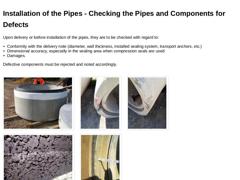
|
Upon delivery or before installation of the pipes, they are to be checked with regard to: -
Conformity with the delivery note (diameter, wall thickness, installed sealing system, transport anchors, etc.)
-
Dimensional accuracy, especially in the sealing area when compression seals are used
-
Damages.
Defective components must be rejected and noted accordingly. (Image: Examination of a manhole component before installation) (Image: Determination of damage … |
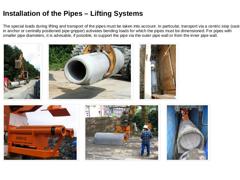
|
The special loads during lifting and transport of the pipes must be taken into account. In particular, transport via a centric stop (cast-in anchor or centrally positioned pipe gripper) activates bending loads for which the pipes must be dimensioned. For pipes with smaller pipe diameters, it is advisable, if possible, to support the pipe via the outer pipe wall or from the inner pipe wall. (Image: Transport of a pipe with a centrally positioned pipe … |
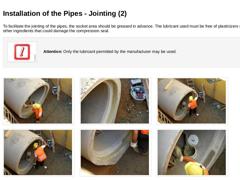
|
To facilitate the jointing of the pipes, the socket area should be greased in advance. The lubricant used must be free of plasticizers or other ingredients that could damage the compression seal. Important: Attention: Only the lubricant permitted by the manufacturer may be used. (Image: Greasing the pipe socket to reduce resistance when jointing the pipes together - Image 1) (Image: Greasing the pipe socket to reduce resistance when jointing the pipes … |
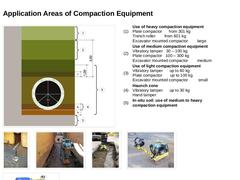
|
(Image: Trench zone - Allocation of compaction equipment) |
(1) |
Use of heavy compaction equipment
Plate compactor from 301 kg
Trench roller from 601 kg
Excavator mounted compactor large
|
|
(2) |
Use of medium compaction equipment
Vibratory tamper 30 – 100 kg
Plate compactor 100 – 300 kg
Excavator mounted compactor medium |
|
(3) |
Use of light compaction equipment
Vibratory tamper up to 60 kg
Plate compactor up to 100 kg
Excavator mounted compactor small |
|
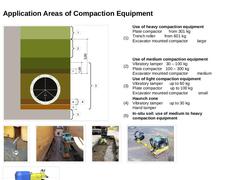
|
(Image: Trench zone - Allocation of compaction equipment) |
(1) |
Use of heavy compaction equipment
Plate compactor from 301 kg
Trench roller from 601 kg
Excavator mounted compactor large |
|
(2) |
Use of medium compaction equipment
Vibratory tamper 30 – 100 kg
Plate compactor 100 – 300 kg
Excavator mounted compactor medium |
|
(3) |
Use of light compaction equipment
Vibratory tamper up to 60 kg
Plate compactor up to 100 kg
Excavator mounted compactor small |
|
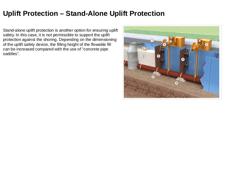
|
Stand-alone uplift protection is another option for ensuring uplift safety. In this case, it is not permissible to support the uplift protection against the shoring. Depending on the dimensioning of the uplift safety device, the filling height of the flowable fill can be increased compared with the use of "concrete pipe saddles”. (Image: Stand-Alone Uplift Protection) |
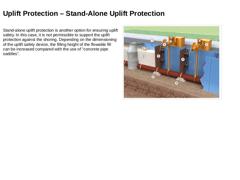
|
Stand-alone uplift protection is another option for ensuring uplift safety. In this case, it is not permissible to support the uplift protection against the shoring. Depending on the dimensioning of the uplift safety device, the filling height of the flowable fill can be increased compared with the use of "concrete pipe saddles”. (Image: Stand-Alone Uplift Protection) |